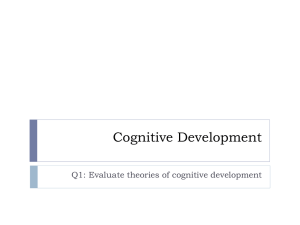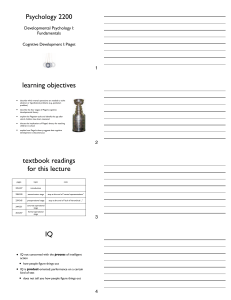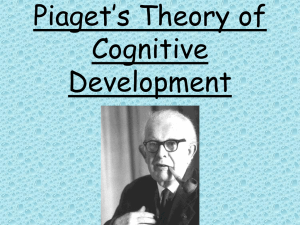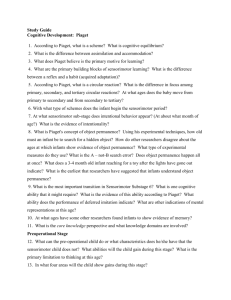Piaget's Stage Theory
advertisement
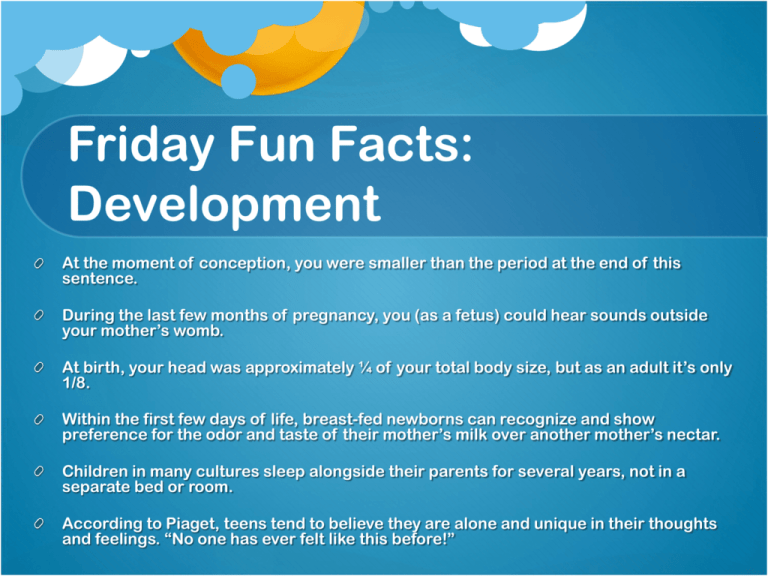
Friday Fun Facts: Development At the moment of conception, you were smaller than the period at the end of this sentence. During the last few months of pregnancy, you (as a fetus) could hear sounds outside your mother’s womb. At birth, your head was approximately ¼ of your total body size, but as an adult it’s only 1/8. Within the first few days of life, breast-fed newborns can recognize and show preference for the odor and taste of their mother’s milk over another mother’s nectar. Children in many cultures sleep alongside their parents for several years, not in a separate bed or room. According to Piaget, teens tend to believe they are alone and unique in their thoughts and feelings. “No one has ever felt like this before!” My body doesn’t match my brain!?! Girls begin puberty 2 years before boys do. That being said, girls will hypothetically be ready to “reproduce” 2 years before boys or even earlier! So, why is it illegal for an 18 year old boy to reproduce with an 15 year old girl? Cognitive Development Awesome!.... Wait…. What does cognitive mean? **Scientific study of behaviors and mental processes.** ??????? Cognitive Development Progress in child’s way of thinking, ability to reason, remember, and problem solve In other words- the way we perceive the world. How do you know what you know? Unlike physical development, which happens rather naturally; mental processes are LEARNED. Infants and small children are like sponges Every experience pushes the child in a direction Children also learn through: associations, assimilations, rewards and punishments and of course, mimicking!! The Importance of Schemas Jean Piaget believes that children are natural experimenters driven to explore and understand their environment. 1, 2, 4, 8…? What’s next? Schemas- act as patterns that organize our interactions with the environment. HELP US UNDERSTAND Like a filing cabinet Organ The Importance of Schemas (example documents) Schemas, our tools for learning about the world, are enlarged and changed throughout our lives in two different ways: 1. Assimilation: Make new information fit an existing schema already in our minds Calling a zebra a “horse” **Adding new sheets to your existing folder** aSSimilation = adding to Same folder 2. Accommodation: Change existing schemas or create new ones in our minds Zebra is a different animal, so a new “zebra” schema is created Evidence of development **Make a NEW folder for this different knowledge** aCCommodate = Change (c) and Create (c) Example Example: On September 11th, 2001, a plane flew into the Twin Towers (on “accident”); shortly after, another plane flew into the Twin Towers(forcing us to accommodate this information. – very difficult for some people so they watched it over and over to make sense of the info On a blank sheet of paper try to draw this same figure Could you do it? If you could, GOOD JOB; you most likely have had artistic training. If you’re like the rest of us and could not draw this it is because we lack the necessary artistic schema and cannot ASSIMILATE what we see. With practice and training, we could ACCOMMODATE the new information and then easily draw the figure. In Groups or alone… 1. Read the information provided 2. Predict how a child might interpret the information if they were assimilating and/or accommodating the info. Happy Monday How do children change their Poo-Schema from birth to early childhood? Assimilate poo- Accommodate pooReview homework. How do we study cognitive development? Longitudinal studies: test one group of participants over a period of time Measure vocabulary of 50 six-year olds at ages 6, 8, 10 More accurate and sensitive to developmental changes Longer, more difficult, and more expensive The marshmallow test…. And future success How do we study cognitive development? Cross-sectional studies: test and compare groups of participants of different ages at a single point in time Compare vocabulary of 50 six-year olds, 50 eight year olds, 50 ten year olds Quicker, easier and cheaper Less accurate and sensitive to developmental changes Jean Piaget Piaget and his Theory “My real concern is the explanation of what is new in knowledge from one stage in development to the next.” Piaget’s Stage Theory of Cognitive Development Stage: Developmental period during which a child demonstrates “new” behaviors and capabilities Predict how a child in this stage of cognitive development understands the world. Stage 1: Sensorimotor Period Children in this stage understand the world through their senses and motor activities such as grasping, sucking, seeing, touching, tasting, etc. Stage lasts from birth until significant language is acquired, about 2 years old. Abilities: Uses senses and motor skills to explore and develop new schemas Stage 1: Sensorimotor Limits: Thinking is limited to the sensible here and now. No schema for things not right here, right now. “Out of sight, out of mind.” Children Start to understand object permanence around 8 or 9 months What if we had no object permanence? “A-not-B error” committed until 12 months old What does the A not B error show in terms of cognition? What is object permanence? How does creating mental image schemas help children understand object permanence? Example: Stage 1- sensorimotor ages 0-2 Toy: Jack in the Box Why? A child in the sensorimotor stage of development does not understand object permanence yet. Without the concept of object permanence the child will think, “out of sight, out of mind.” The toy will help the child begin to develop the concept of object permanence, which will help move them into stage 2 of cognitive development. Thinking like an Elf Ok little elves, try to design a toy that is appropriate for a child in stage 1 of Piaget’s theory of cognitive development? AgesToyWhy? Sensorimotor Milestone Think of a sensorimotor milestone from your life. (new achievement during this time period that COULD move you into the next stage or could just be a new milestone.) Age? What happened How is it sensorimotor? Sensorimotor Milestones Milestones in the early part of this stage are hard to describe Towards the later parts of this stage (18-24 months) the child will begin recognizing symbols and also using symbols to represent the world. child will not be able to USE the letters to spell quite yet, but simply recognize the symbols as representing sounds. Children cannot really SPELL but can recite words around the 18th month. At this time children learn about one word every TWO HOURS!!! Operations= mental processes such as perception, memory, imagination, retrospective (hindsight). Ability to solve a problem without physically doing it. Predict how a child in this stage of cognitive development understands the world. Stage 2: Pre-operational Period Children in this stage understand the world through their increasingly developed language and symbolic thinking. Stage lasts from 2 years old until children have the ability to think in concrete operations (such as reversibility)- about 7 years old. Operations= mental processes such as perception, memory, imagination, retrospective (hindsight) Stage 2: Pre-operational Abilities: Uses language but not concrete logic, can draw pictures that represent things. Limits: Children do not have logical thoughts and cannot understand (*watch for abilities and lack of logical thinking/communicating*) conservation, (idea that quantity changes with shape) reversibility (a ability to reverse a sequence to the starting point) Children at this stage also display egocentric thinking (only sees from their POV) animistic thinking, (believes inanimate objects (like poo) are living.) Pre-operational Milestones Child will develop the ability to making meaning of images, gestures and words to describe events, people and objects. Child develops language during this period. Child learns to play using the imagination to create stories and situations. Child can group things together by single characteristics such as red blocks with red blocks regardless of blocks shape; or all the cubes together and the triangles together, regardless of color. Thinking like an Elf Ok little elves, try to design a toy that is appropriate for a child in stage 2 of Piaget’s theory of cognitive development, the preoperational stage? AgesToyWhy? Pre-operational Milestone Think of a preoperational milestone from your life. (new achievement during this time period that COULD move you into the next stage or could just be a new milestone.) Age? What happened How is it preoperational? Operations= mental processes such as perception, memory, imagination, retrospective (hindsight) Predict how a child in this stage of cognitive development understands the world. Stage 3: Concrete Operational Period Children in this stage understand the world through trial and error and physical objects. Stage lasts from birth until the child can think ABSTRACTLY. Abilities: Children CAN perform operations on concrete objects. (objects that are physically in existence) Child understands seriation – ability to sequence objects based on changing dimensions. Learn through trial and error not abstract strategy Stage 3 Concrete Operational Limits: Children cannot think abstractly(objects that never EXIST physically) or hypothetically. Child cannot answer “what if” questions. Thinking like an Elf Ok little elves, try to design a toy that is appropriate for a child in stage 3 of Piaget’s theory of cognitive development, the concrete operational stage? AgesToyWhy? Concrete operational Milestone Think of a concrete operational milestone from your life. (new achievement during this time period that COULD move you into the next stage or could just be a new milestone.) Age? What happened How is it concrete operational? Operations= mental processes such as perception, memory, imagination, retrospective (hindsight) Formal Operational Period Understanding abstract concepts Child can think hypothetically and about the future Deductive reasoning Logical reasoning where the conclusion follows a set of premises. More systematic, logical, reflective in problemsolving- thinking OUTSIDE the box. Understand what is meant by unknown quantity X in algebrUH. RECAP Stage 1- 0-2 Sensorimotor (only know what your senses tell you) When I was 2 I learned with my SENSES Stage 2- 3-7 Preoperational (symbolic thought, ABCs) When I was 5 I started PREschool and learned my ABCs Stage 3- 7-11 Concrete operational ( Trial and error to learn) When I was 11 I found my favorite CONCRETE mixer flavor through trial and error Stage 4- 12+ Formal operational (can think outside the box, abstractly) When I was 13 I went to my first FORMAL dance and my outfit was OUTSIDE of the box Thinking like an Elf Ok little elves, try to design a toy that is appropriate for a child in stage 4 of Piaget’s theory of cognitive development, the Formal operational stage? AgesToyWhy? Formal operational Milestone Think of a formal operational milestone from your life. (new achievement during this time period that COULD move you into the next stage or could just be a new milestone.) Age? What happened How is it formal operational? Criticisms of Piaget’s Theory Underestimated young children Individual differences Changes are too abrupt Ignorance of cultural factors Did Piaget Underestimate Infants? Kids understand object permanence at younger ages than Piaget thought Habituation: child is used to something (shows little surprise) Dishabituation: child shows obvious surprise or curiosity because he/she is seeing something new Criticisms of Piaget Infant shows habituation (lack of surprise) at this expected outcome Infant shows dishabituation (surprise, stare longer) at this impossible outcome Reflecting on Piaget’s Theory What are the implications of Piaget’s theory for parents and teachers? Children build understanding of the world through interaction and association. Kids are not PASSIVE “buckets” waiting to be filled with a teacher’s knowledge! Young people are incapable of adult logic!


